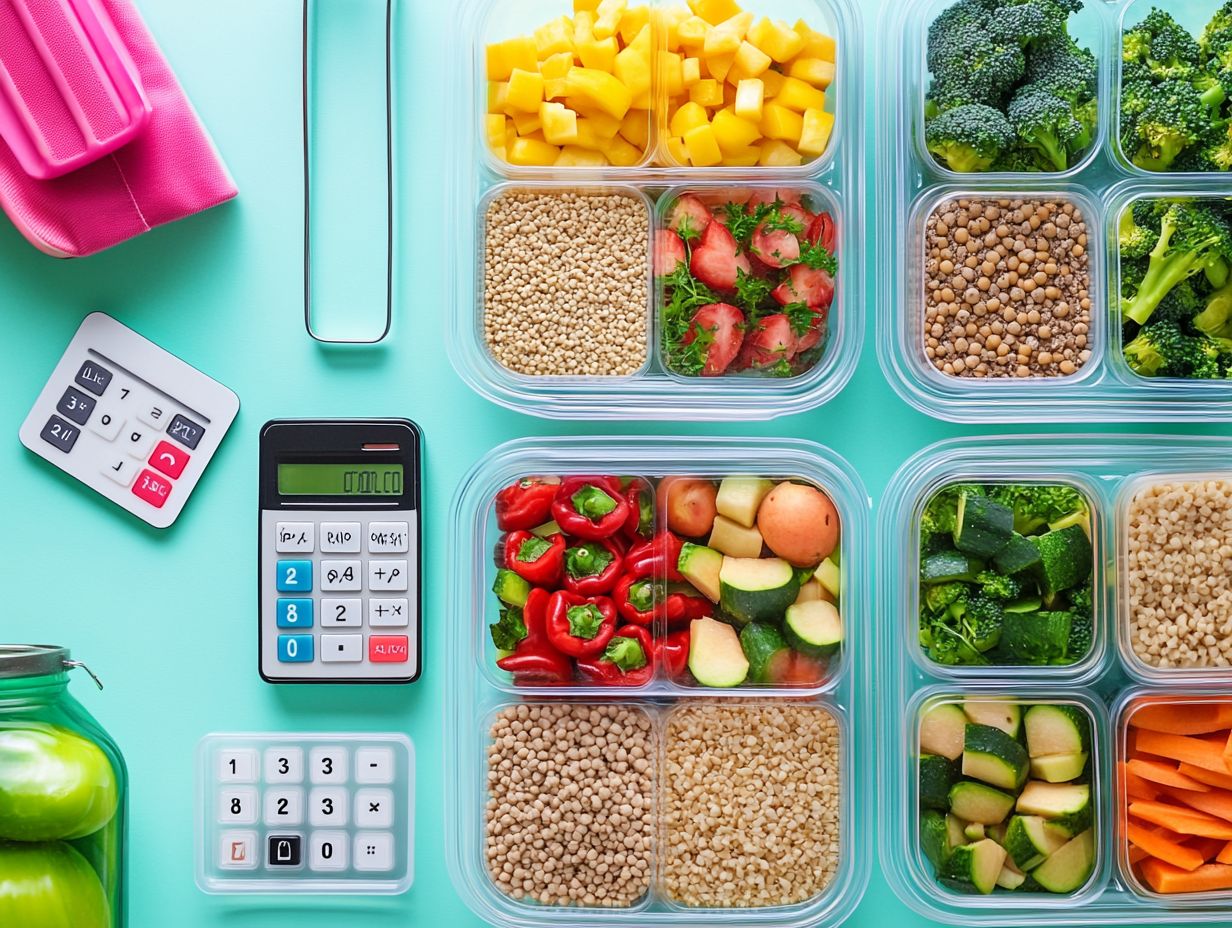Meal Planning Hacks That Keep You Full and Frugal
In today’s fast-paced world, meal planning is a game-changer for your health and finances. When you take the time to plan your meals, you’re not just making healthier choices; you’re also saving money on groceries.
This article dives into practical tips for smart grocery shopping, meal prep techniques that fit your busy schedule, and ways to incorporate affordable, filling ingredients into your diet. Plus, you’ll find some creative meal ideas that cater to various dietary needs, keeping your meals exciting and budget-friendly.
Get ready to take control of your kitchen and your budget!
The Importance of Meal Planning
.jpg_00.jpeg)
Meal planning is really the foundation of a well-balanced and health-conscious lifestyle. It lets you take charge of your dietary needs while also keeping your grocery shopping and budget in check.
When you plan your meals thoughtfully, you can achieve a nutritional balance that satisfies your culinary creativity, uses seasonal ingredients, and helps reduce food waste. Plus, it’s great for portion control during family meals and opens up a whole world of meal ideas that cater to various dietary restrictions and preferences.
Cooking from scratch becomes not only enjoyable but also super fulfilling.
Benefits for Health and Budget
The benefits of meal planning go way beyond just whipping up healthy recipes; it can really make a difference in both your health and your budget. It’s a smart way to keep your nutrition on point while accommodating various dietary needs.
By preparing meals ahead of time, you can cut down on food waste, avoid those pesky impulse buys, and ensure you’re enjoying balanced meals that boost your well-being.
This proactive approach not only helps you improve your nutrition by adding a variety of fruits, veggies, and whole grains into your diet but also plays a big role in managing your weight. When you have carefully planned meals, it’s easier to control portion sizes and resist the lure of unhealthy snacks.
Plus, from a financial perspective, regular meal prep helps you stick to your budget. By planning your grocery lists ahead of time, you can capitalize on sales and seasonal produce, which means you can lower your overall grocery costs.
Ultimately, the combo of better health and economic savings makes meal planning a savvy strategy for anyone wanting to level up their lifestyle.
Smart Grocery Shopping for Meal Planning
.jpg_01.jpeg)
Smart grocery shopping is key to effective meal planning, and it can really impact your meal expenses while making sure you get the best bang for your buck.
When you create a solid shopping list based on your meal plan, you’ll be able to avoid those sneaky impulse buys, focus on seasonal ingredients, and capitalize on bulk buying deals. This strategy not only saves you time while you’re in the grocery store but also helps you keep your food storage and organization in tip-top shape at home.
Tips for Saving Money and Time
You can save both money and time while grocery shopping with a few simple tips that boost your meal prep efficiency and overall cooking experience.
By using cooking shortcuts and food prep techniques, you can streamline your kitchen routine, cut down on the hassle of meal tracking, and really make the most of your kitchen tools.
Try planning your meals for the week ahead; this not only saves you time during shopping but also helps you avoid those pesky impulse buys.
Organizing your grocery list based on the layout of the store can speed up the process even more. Once you’re back from shopping, effective food storage is key—labeling your containers and using freezer-friendly techniques makes meal access easier and cuts down on waste.
Embracing batch cooking can be a total game-changer too. You can prepare larger portions that you can freeze for later use.
And with the right kitchen gadgets, like slow cookers and food processors, meal prep can turn into a smooth and enjoyable activity instead of feeling like a chore.
Meal Prep Techniques for Busy Schedules
.jpg_10.jpeg)
Meal prep techniques can really be a lifesaver for anyone with a busy schedule.
They let you whip up delicious, healthy meals ahead of time, so you always have quick options ready when hunger strikes.
Embracing batch cooking and prepping freezer meals helps you make the most of your time in the kitchen and keeps your meal organization under control.
Plus, using some clever culinary hacks can totally elevate your meal prep game, making it easier than ever for you to stick to those meal plans.
Batch Cooking and Freezing Meals
Batch cooking and freezing meals is a clever trick that can really amp up your meal efficiency. You get to whip up larger quantities of food in one go and stash them away for later. Not only does this save you time, but it also sparks your culinary creativity, letting you play around with new flavors and styles while keeping a nice variety of quick meals at your fingertips.
By pairing batch cooking with meal planning, you can choose recipes that use similar ingredients. This way, you cut down on waste and make the most of your grocery budget.
To freeze meals effectively, grab some high-quality, airtight containers or freezer bags. They’ll help keep freezer burn at bay and your meals fresh for longer. Don’t forget to label and date them so you know exactly what you’ve got stored away.
When it’s time to reheat, think about using the stovetop or oven instead of the microwave. This helps to keep the texture and flavor intact. And hey, throwing in some herbs and spices can really elevate those frozen meals, ensuring your culinary experience stays enjoyable even days down the line.
Incorporating Affordable and Filling Ingredients
.jpg_11.jpeg)
Incorporating affordable and filling ingredients into your meals is key to maintaining a healthy diet without emptying your wallet, and it really opens up a world of culinary possibilities for you.
By focusing on a variety of protein sources, fiber-rich foods, and healthy fats, you can whip up frugal meals that not only satisfy your hunger but also excite your taste buds with influences from ethnic cuisines and fun meal substitution options.
Protein, Fiber, and Healthy Fats
Understanding the role of protein sources, fiber, and healthy fats in your diet is key to achieving nutritional balance and keeping your meals diverse while also meeting your unique dietary needs. By checking out nutrition labels and playing around with meal customization, you can make sure your meals not only taste amazing but also support your overall health.
These macronutrients are crucial for keeping your energy levels up, making you feel full, and supporting various functions in your body.
For instance, affordable protein sources like beans, lentils, and eggs can easily fit into your meals, giving you budget-friendly options to meet your protein needs.
Don’t forget about fiber-rich foods like whole grains, fruits, and vegetables—they’re essential for digestive health and help regulate blood sugar and cholesterol levels.
Plus, adding healthy fats from sources like avocados, nuts, and olive oil not only boosts flavor but also helps your body absorb essential vitamins. So, making room for these nutrients is a smart move for a well-rounded diet.
Creative and Budget-Friendly Meal Ideas
Creative and budget-friendly meal ideas are a great way for you to keep your dining experience fresh and exciting without breaking the bank.
By exploring inexpensive recipes and adding in some vegetarian options, you can make sure your family meals are not just satisfying but also diverse and full of flavor.
Plus, experimenting with different cooking techniques can really elevate the presentation and enjoyment of each dish.
Meal Suggestions for Different Dietary Needs
When you’re thinking about meal suggestions for different dietary needs, it’s all about embracing meal customization and tweaking recipes to fit various preferences and restrictions. Whether you’re looking for gluten-free or vegetarian options, adding some ethnic cuisine can spice things up with healthy snacks and meals that not only taste amazing but also respect dietary guidelines.
By mixing in a variety of ingredients and cooking techniques, your meal planning can turn into a colorful and inclusive experience. For example, swapping out traditional pasta for spiralized zucchini makes a tasty gluten-free alternative, and chickpeas are a fantastic way to boost protein in vegetarian dishes.
To truly elevate your menu, why not dive into globally inspired dishes? Think Thai curry with creamy coconut milk and a medley of vibrant vegetables or a Mexican quinoa salad brimming with beans, corn, and avocado. These tweaks not only help you meet dietary restrictions but also unleash your creativity in the kitchen, turning cooking and dining into a much more enjoyable adventure.






